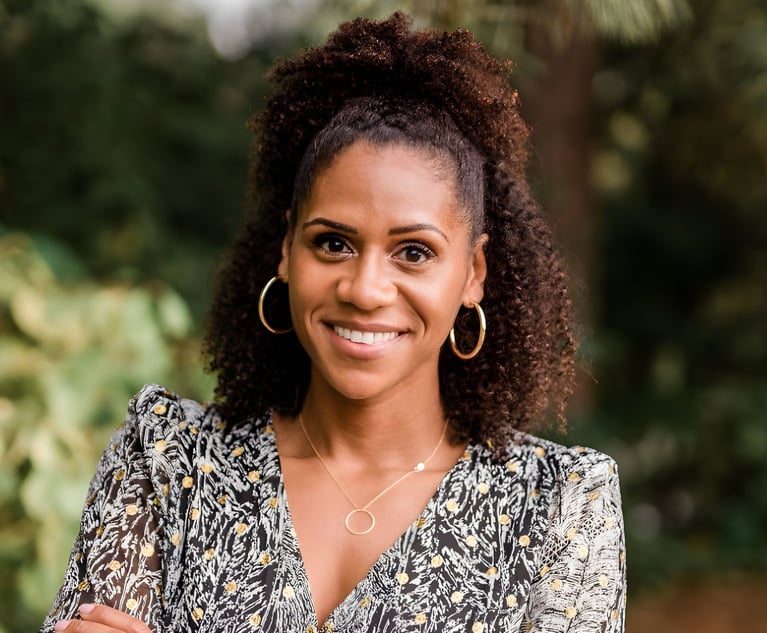Hello? It's Your Client Calling. Where Are Your D&I Initiatives?
Earlier this year, it was a slap in the industry's face and a drawback to any progress thought to have been made when mega firm Paul, Weiss, Rifkind, Wharton & Garrison shared a photo of its class of newly promoted partners.
April 25, 2019 at 11:45 AM
6 minute read
 Jessica Mazzeo, Griesing Law
Jessica Mazzeo, Griesing Law
It has been 20 years since “Diversity in the Workplace: A Statement of Principle” was signed by over 500 general counsels at Fortune 1000 companies. The Statement of Principle, an effort led by Charles Morgan, then-BellSouth general counsel, said: “In making our respective decisions concerning selection of outside counsel, we will give significant weight to a firm's commitment and progress in this area.” This was followed up with the 2004 Call to Action that was developed by Roderick Palmore during his tenure as general counsel of Sara Lee. The Call to Action stated, in part, that general counsel “will make decisions regarding which law firms represent our companies based in significant part on the diversity performance of the firms.” Both of these were mighty efforts for an industry that has been slow with change and progress in areas where other industries routinely excel. Last year, I wrote about why just talking about diversity and inclusion was not enough to make an impact at law firms. My article focused on statements made about diversity and inclusion that end up being just that—words with no action. However, now it seems that words are turning into action as I know of several firms that have recently had clients say “show us your diversity or we find new counsel.”
Earlier this year, it was a slap in the industry's face and a drawback to any progress thought to have been made when mega firm Paul, Weiss, Rifkind, Wharton & Garrison shared a photo of its class of newly promoted partners. They say a picture is worth a thousand words and when the photo was released—showing 11 white male faces out of a class of just 12 partners—the announcement drew vast and fierce criticism. But while Paul Weiss has since been outspoken on realizing it must set better industry examples when it comes to diversity in the profession, the photo seems to have finally struck the cord needed to affect change. Shortly after its release, more than 170 general counsel and corporate legal officers signed an open letter to Big Law firms stating their companies will prioritize legal spend on those firms that commit to diversity and inclusion. The letter reads in part, “We, as a group, will direct our substantial outside counsel spend to those law firms that manifest results with respect to diversity and inclusion, in addition to providing the highest degree of quality representation. We sincerely hope that you and your firm will be among those that demonstrate this commitment.” If there were not already enough reasons to develop and sustain a diverse culture in the workplace, having clients take away business will probably (and sadly) be the main driving force behind law firms finally catching up with the times.
The legal industry continuously fails to realize that it is falling behind other professions and industries that have already understood and embraced diverse workforces. In 2010, the National Association of Minority- and Women-Owned Law Firms (NAMWOLF) created the Inclusion Initiative, a “collaborative effort of 33 forward-looking companies committed to an immediate and measurable increase in the retention of minority- and women-owned law firms by corporate America. Inclusion initiative companies believe that diverse law firms are a critical part of the solution to the diversity challenge in the legal profession. Since launching the Inclusion Initiative, participating companies have spent over $1 billion on minority- and women-owned law firms and their total annual expenditures have averaged over $200 million per year for the last six years.” Additionally, according to a July 2017 study by DiversityLab, many public companies have already begun implementing policies aimed at ensuring outside legal counsel was diverse and inclusive, including some that have pledged commitment to NAMWOLF's Inclusion Initiative. The study showed that as of 2017, Facebook requires outside counsel working on its legal matters to be comprised of at least 33 percent women and ethnic minorities as well as provide evidence that the law firm is creating “clear and measurable leadership opportunities for women and minorities.” HP will now withhold up to 10 percent of bills from firms that do not meet or exceed its diverse staffing requirements. Further, the study found that for over 10 years, Walmart has reviewed diversity data of its outside counsel including overall law firm demographics, demographics of the team working on Walmart matters, and hours billed by diverse attorneys.
And it is not just corporations making the diversity push either. Here in Pennsylvania, Gov. Tom Wolf issued a mandate in 2015 that ensured a commitment to diversity for its outside legal counsel. Until that point, there was no diversity requirement for professional service companies who were responding to the commonwealth's RFPs for legal work. Since 2015, majority firms seeking to perform legal services for any one of the commonwealth's approximately 250 agencies are required to partner with a small diverse business as part of the RFP process. And the commonwealth didn't stop there—firms serving as the prime contractor are now also required to submit a staff breakdown on projects including how many women and minorities will be assigned to each matter.
So what can your firm do if it finds itself in this predicament of potentially losing longstanding clients or even the inability in attracting new ones due to a lack of diversity? Well first, stop thinking of it as a predicament and think of it as an opportunity for improvement. Long gone are the days where the network of similarly looking lawyers retain and reap all the rewards from everyone else's work. Employees want—even demand—employers who have and support initiatives in the hiring and promotion of women and minorities, and now clients do, too. If you do not adapt to change—change that should have taken place a long time ago—prepare to lose and lose big. Consider hiring an outside consultant to conduct diversity and inclusion training for your entire firm—not just the lawyers. Take a second—and third—look at your hiring practices and internal handbook policies on diversity and inclusion in your workplace. Recognize the efforts and accomplishments of every individual regardless of their race or gender. By taking these steps you will be on the right path to providing a better work environment for your employees and more well-rounded legal advice to your clients. So what are your waiting for? The phone has already been ringing.
Jessica L. Mazzeo is chief operating officer of Griesing Law, where she focuses on overseeing and implementing all of the firm's business operations while establishing policies that promote and retain the firm's culture and strategic vision. In addition to her role at the firm, she provides training for law firms and companies on diversity and inclusion best practices. Mazzeo is vice chair of the committee on diversity and inclusion of the Association of Legal Administrators. She is also a volunteer for the National Association of Minority and Women Owned Law Firms and the Women's Business Enterprise Council of PA-DE-sNJ. Contact her at [email protected].
This content has been archived. It is available through our partners, LexisNexis® and Bloomberg Law.
To view this content, please continue to their sites.
Not a Lexis Subscriber?
Subscribe Now
Not a Bloomberg Law Subscriber?
Subscribe Now
NOT FOR REPRINT
© 2025 ALM Global, LLC, All Rights Reserved. Request academic re-use from www.copyright.com. All other uses, submit a request to [email protected]. For more information visit Asset & Logo Licensing.
You Might Like
View All


Best Practices for Conducting Workplace Investigations: A Legal and HR Perspective
9 minute readTrending Stories
- 1We the People?
- 2New York-Based Skadden Team Joins White & Case Group in Mexico City for Citigroup Demerger
- 3No Two Wildfires Alike: Lawyers Take Different Legal Strategies in California
- 4Poop-Themed Dog Toy OK as Parody, but Still Tarnished Jack Daniel’s Brand, Court Says
- 5Meet the New President of NY's Association of Trial Court Jurists
Who Got The Work
J. Brugh Lower of Gibbons has entered an appearance for industrial equipment supplier Devco Corporation in a pending trademark infringement lawsuit. The suit, accusing the defendant of selling knock-off Graco products, was filed Dec. 18 in New Jersey District Court by Rivkin Radler on behalf of Graco Inc. and Graco Minnesota. The case, assigned to U.S. District Judge Zahid N. Quraishi, is 3:24-cv-11294, Graco Inc. et al v. Devco Corporation.
Who Got The Work
Rebecca Maller-Stein and Kent A. Yalowitz of Arnold & Porter Kaye Scholer have entered their appearances for Hanaco Venture Capital and its executives, Lior Prosor and David Frankel, in a pending securities lawsuit. The action, filed on Dec. 24 in New York Southern District Court by Zell, Aron & Co. on behalf of Goldeneye Advisors, accuses the defendants of negligently and fraudulently managing the plaintiff's $1 million investment. The case, assigned to U.S. District Judge Vernon S. Broderick, is 1:24-cv-09918, Goldeneye Advisors, LLC v. Hanaco Venture Capital, Ltd. et al.
Who Got The Work
Attorneys from A&O Shearman has stepped in as defense counsel for Toronto-Dominion Bank and other defendants in a pending securities class action. The suit, filed Dec. 11 in New York Southern District Court by Bleichmar Fonti & Auld, accuses the defendants of concealing the bank's 'pervasive' deficiencies in regards to its compliance with the Bank Secrecy Act and the quality of its anti-money laundering controls. The case, assigned to U.S. District Judge Arun Subramanian, is 1:24-cv-09445, Gonzalez v. The Toronto-Dominion Bank et al.
Who Got The Work
Crown Castle International, a Pennsylvania company providing shared communications infrastructure, has turned to Luke D. Wolf of Gordon Rees Scully Mansukhani to fend off a pending breach-of-contract lawsuit. The court action, filed Nov. 25 in Michigan Eastern District Court by Hooper Hathaway PC on behalf of The Town Residences LLC, accuses Crown Castle of failing to transfer approximately $30,000 in utility payments from T-Mobile in breach of a roof-top lease and assignment agreement. The case, assigned to U.S. District Judge Susan K. Declercq, is 2:24-cv-13131, The Town Residences LLC v. T-Mobile US, Inc. et al.
Who Got The Work
Wilfred P. Coronato and Daniel M. Schwartz of McCarter & English have stepped in as defense counsel to Electrolux Home Products Inc. in a pending product liability lawsuit. The court action, filed Nov. 26 in New York Eastern District Court by Poulos Lopiccolo PC and Nagel Rice LLP on behalf of David Stern, alleges that the defendant's refrigerators’ drawers and shelving repeatedly break and fall apart within months after purchase. The case, assigned to U.S. District Judge Joan M. Azrack, is 2:24-cv-08204, Stern v. Electrolux Home Products, Inc.
Featured Firms
Law Offices of Gary Martin Hays & Associates, P.C.
(470) 294-1674
Law Offices of Mark E. Salomone
(857) 444-6468
Smith & Hassler
(713) 739-1250






